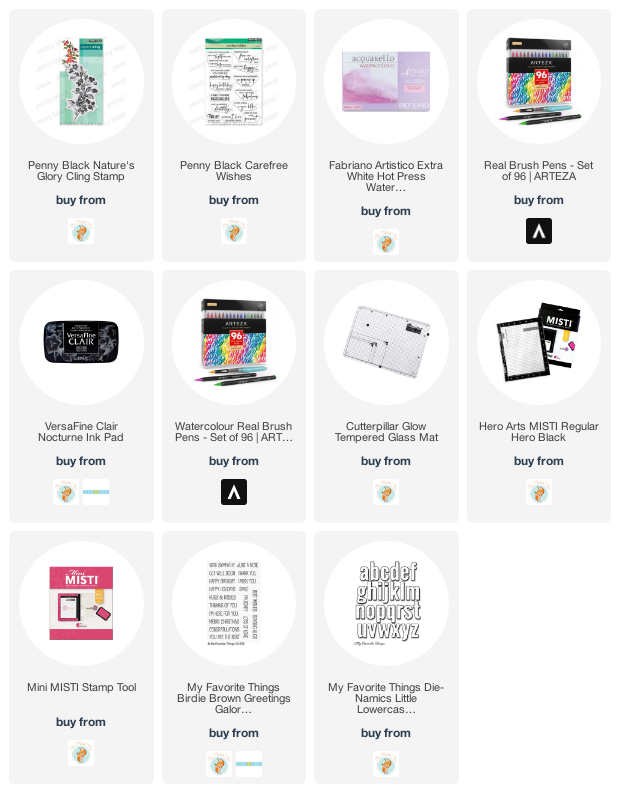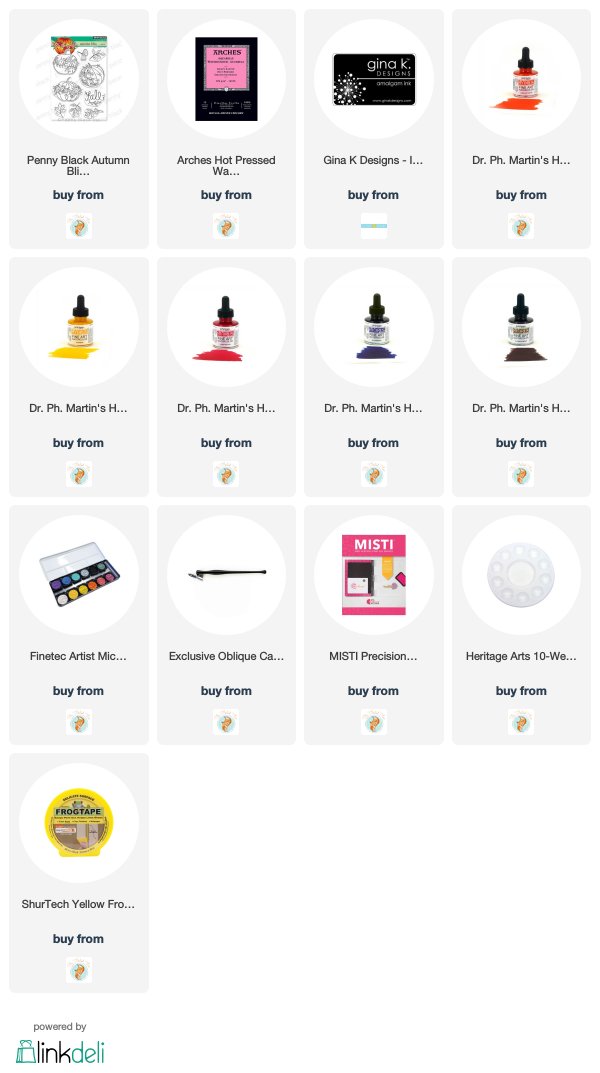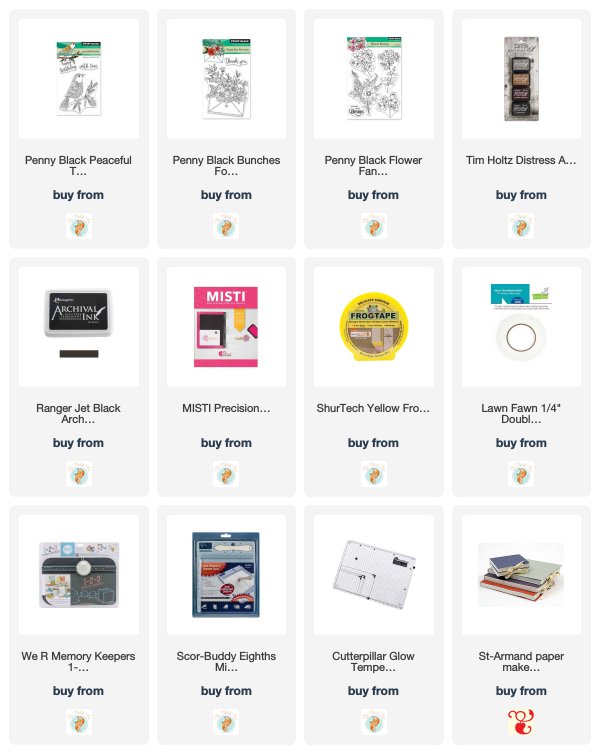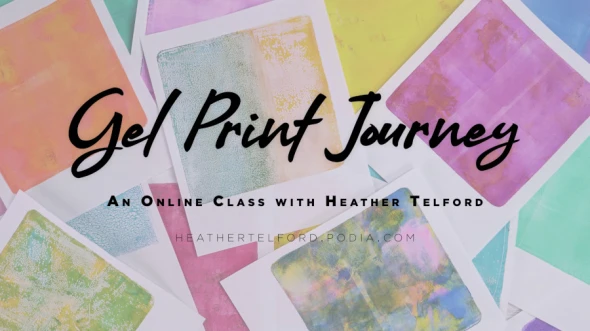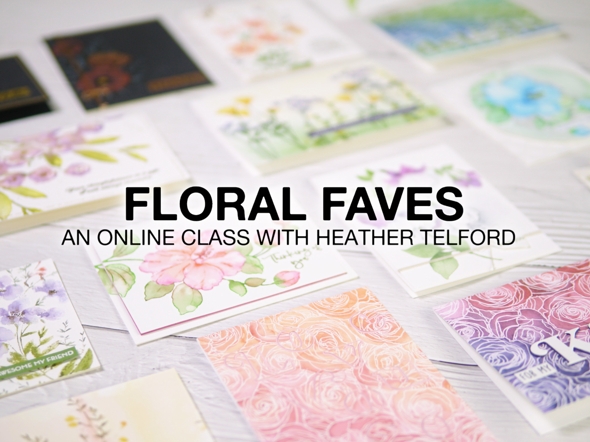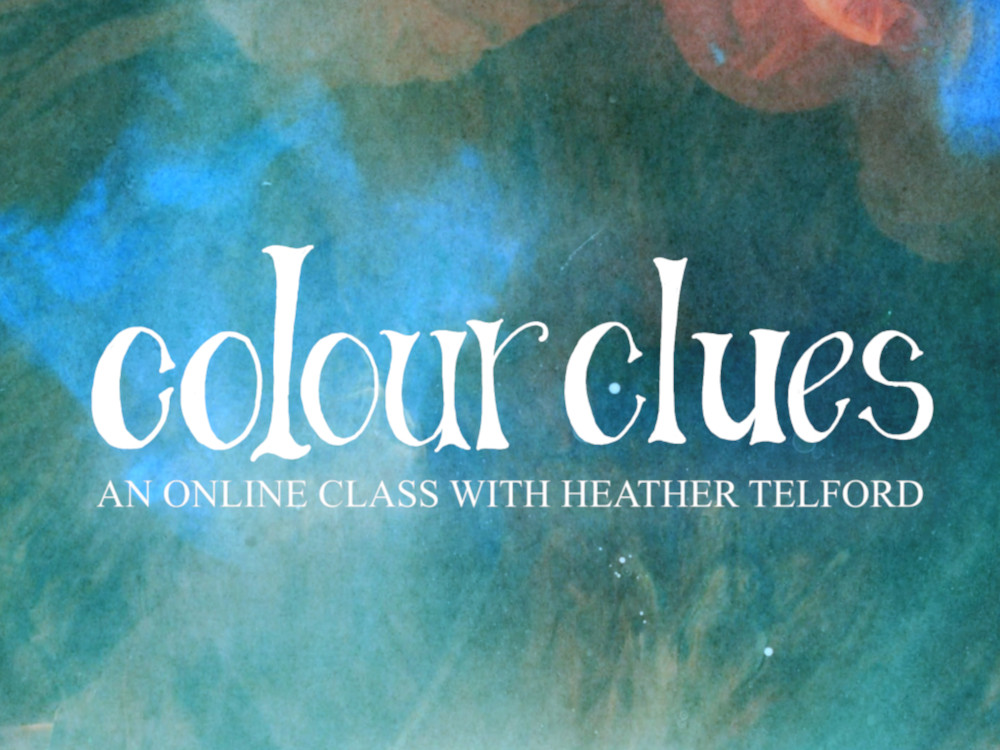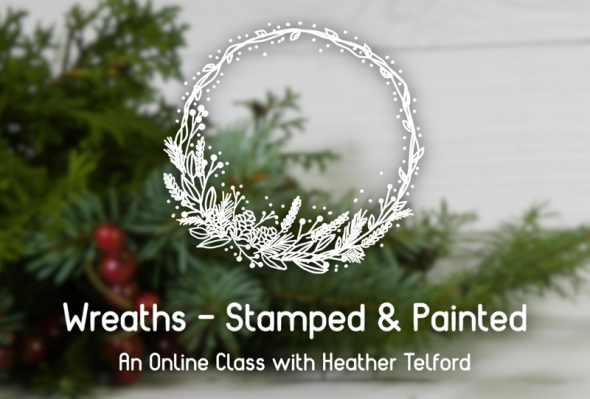Tulips & more tulips
Posted: February 21, 2024 Filed under: Echidna Studios, sennelier watercolours, tulip background, tulip set, Watercolour | Tags: digital stamps, Echidna Studios, Faber-Castell Albrecht Durer Watercolour pencils, Faber-Castell Polychromos Colour Pencil, Fabriano Watercolour Paper, sennelier watercolours 11 Comments
If there are tulips already blooming where you live you must let me know in the comments! It will be another two or three months before they bloom around here. All the more reason to have some blooming here on the blog. The group you see on the card above are part of a new digital stamp called ‘tulip background‘ from Echidna Studios. The whole image is a landscape oriented design and I printed it on hot pressed watercolour paper to be 8½” wide which gave me plenty of choice when deciding which part to use on a portrait oriented card.

I used Sennelier watercolours to paint the design using various mixes of four different reds and pinky red paints. I also used one of the reds to give the green paint a more muted realistic tone. Once I had painted all the tulips and stems I used polychromos pencils to add extra shading and shadow. This is a technique I learnt from Kathy Racoosin and it always adds to the finished panel. I ruled a narrow black line around the panel to frame it.

The flowers below are from a co-ordinating digital set simply called ‘tulip set‘ also from Echidna Studios. The set includes three individual tulips. I didn’t paint this one, my daughter did, using watercolour pencils. She also fussy cut each of the three tulips to create a pretty layered arrangement. This post includes an affiliate link to The Foiled Fox, if you use it I receive a small commission at no extra cost to you.

Old Stone Doorway
Posted: February 3, 2023 Filed under: Echidna Studios, old stone doorway, sennelier watercolours, Simply Graphic, Watercolour | Tags: Echidna Studios, Faber-Castell Albrecht Durer Watercolour pencils, Ranger archival inks, sennelier watercolours, Simply Graphic 12 Comments
Isn’t this a sweet front path and door? It makes me want to head inside or wander around the garden. This digital stamp is another design by my daughter which is available in her etsy store, Echidna Studios. I printed it on Arches cold press watercolour paper. You know I generally use Fabriano hot press watercolour paper but I am trying to ‘use what I have’ so I pulled out the Arches for a change. I like how the texture of the paper adds texture to the front of the house.

Using my Sennelier watercolour paints I painted a wash of brown over the brickwork, blue over the door and grey for the stonework. I also mixed a bluey green for the hedges. Next I switched to watercolour pencils and added shading to the bricks and stones, coloured the leaves and painted from the tip of my pencils to make the window and door frames grey and the reflections light blue. The sentiment is from Simply Graphic and is stamped in prize ribbon sketch archival ink

I almost stopped a couple of times as I wasn’t happy with the colours I had chosen and the lack of detail in the washes. I did keep going though and it pulled together. One thing that helps is that I didn’t use too many colours and I like the way the watercolour fades away at the edges. There are little white patches where I didn’t touch up the painting and I think they work too in adding a highlight here and there. I have printed another one out because a red brick house might also be fun to do.
The designer of this stamp is coming over for dinner tonight so I will ask where this door is in real life…
(Compensated affiliate links used when purchasing from Foiled Fox)
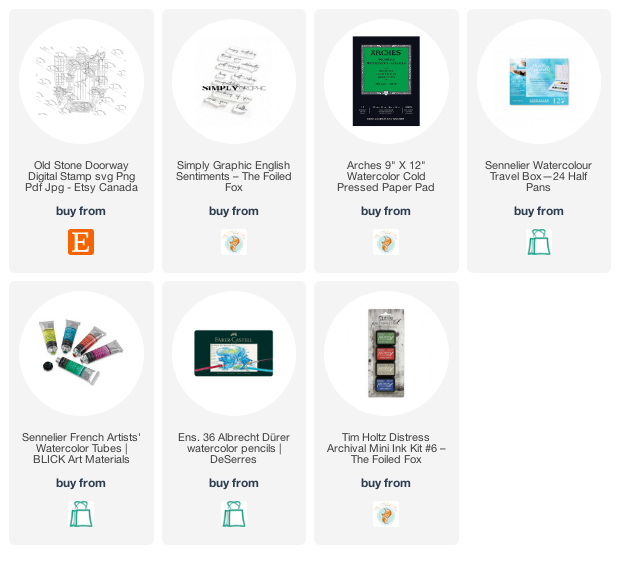
Stamping with Arteza Real Brush pens
Posted: April 17, 2020 Filed under: Arteza, nature's glory, Penny Black, Tutorial, Watercolour, watercolour real brush pens | Tags: Arteza, Fabriano Watercolour Paper, Penny Black stamps, Tutorial, video 10 CommentsHi there, this pretty stamp, ‘nature’s glory’ is making its second appearance on the blog and I’ve paired it up with Arteza real brush pens. I did all the inking with the brush pens and made a video to give you an idea of the process. One of the tricky steps when creating watercolour cards with stamps is when, where and how much water to add, hopefully the video will give you an idea.
You probably noticed in the video the way the brush pen bristles were able to easily get into small sections of the stamp so I could ink the flowers, berries and leaves. I spritzed the stamp before pressing onto the hot pressed watercolour paper so the inks would blend on the stamp rather than me blending them on the paper. I love the softness of the blends including the areas that get more water and the ones that look a little dry because they got less water.
The soft background leaves and flowers were all stamped with ink left on the stamp after doing the bold images. The ink is certainly intense enough that an extra spritz of water is all you need in order to stamp the pale images that appear to be further back between the branches. Dabbing these pale images with a paper towel after stamping makes them even paler and removes any liquid sitting on the surface.
I even had enough ink on the stamp to get a pale print on my envelope then finished with splatter as you know I like to do.
The card below was done with the same stamping technique but I created the soft coloured background at the beginning of my process. I scribbled the blue, yellow and green pens on my glass mat first, spritzed with water then swiped the hot pressed watercolour panel through the ink picking up sections of diluted colour which I dried before transferring the panel to my stamp positioner to do all the flowers. If you are wondering about the sentiment, it is for one of my friends who was told this by a student! When she relayed the experience to me I knew it had to become a card. I did a bit of partial stamping with MFT ‘birdie brown greeting stamps’ then cut the letters b, a, b, y from dark green cardstock (I know it looks black ) with MFT ‘little lowercase dies’.
If you are a teacher connecting with your students on line, encouraging them and trying to come up with methods that work in the current situation please know I think you are the best of the best…baby!
Supplies
Three colour brusho video
Posted: April 9, 2020 Filed under: Brusho, flutterby, Penny Black, Tagged, Tutorial, Watercolour | Tags: Brusho, Faber-Castell Polychromos Colour Pencil, Fabriano Watercolour Paper, Penny Black creative dies, Penny Black stamps, Tutorial, video 7 Comments
A while back I posted three cards all painted with the same three brusho paint colours and my Welsh friend, Karen requested a video. Well this is it, a different stamp and three different colours (Brusho sunburst lemon, prussian blue, rose red) but the same technique. Here is the one that prompted the video request.

As with the card above I embossed the outline stamp, ‘flutterby’ in gold powder then swiped up a brusho background by sprinkling brusho on my glass mat then spritzing water over it to activate the powders and turn them into liquid watercolour paint. From there I moved onto painting petals and leaves with individual colours and secondary colours. Take a look at the video and you will see what I mean.

After all the painting was done I added some extra shading in shadow areas with Faber-Castell polychromos pencils and some gold thread detail. The sentiment is from PB ‘banner sentiments’ gold embossed and die cut with a die from the PB ‘tagged’ set.

One of the things I like about this technique is the way the background works with the painted images even though the are painted right over the top of a multicoloured panel. The colours work because they are the same colours and because the background is not too bold. You can see in the tulip on the left what the true colour of the rose red brusho is, but the ones that are painted over the blue background still look red, just a deeper red perhaps in shadow not full sun.
Happy Easter my friends. Stay home, stay healthy, stay hopeful and maybe try a new art or craft technique!
Supplies
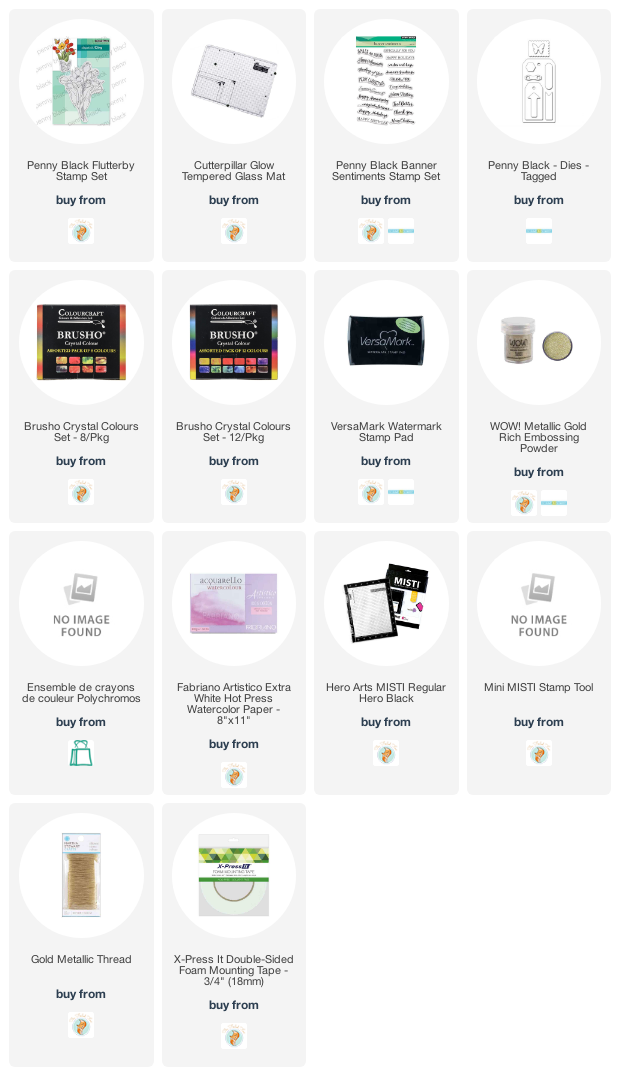
Lovely Lilacs video
Posted: April 3, 2020 Filed under: lovely lilacs, Penny Black, Tutorial, Watercolour | Tags: Fabriano Watercolour Paper, Penny Black stamps, Ranger Distress inks, Tutorial, video 25 Comments
I am so happy to have a video for you today especially as so many of us are staying home to stay healthy. I hope this simple technique and pretty card featuring Penny Black’s ‘lovely lilacs’ set will inspire you in your creating. Check out the video below and then read further for the different colour combinations I came up with. They all require a light and a dark colour in the same ‘family’ for the flowers and a green for the stems. That’s it; so simple and so pretty!
The inks are listed in the video and linked below but just for reference while you are reading, on the card above I used milled lavender distress ink, seedless preserves & peeled paint distress markers and shady lane versafine clair ink for the sentiment. All the cards are stamped on Fabriano hot pressed watercolour paper. The sentiments are from two different PB sets, ‘carefree wishes’ and ‘magical friendship’.

As I have been home a lot more than usual I have been spending quite a bit of time making videos. I’ve said before they take me a long time and that is still true but I am feeling more confident with the editing software since I’ve spent days sitting in front of it! Other than the mammoth grocery runs ( I did one today that I am hoping will feed the four of us for two weeks) and some outdoor exercise, I haven’t been out and about at all. I am sure it is the same for many of you.
The card above is the first one I did with this technique and it was stamped with shaded lilac distress ink, blueprint sketch & forest moss distress markers. I think this might be my favourite colour combo.

This red and pink one ended up with splatter and was stamped with worn lipstick distress ink and aged mahogany & forest moss distress markers.

I’m not sure that lilacs come in all these colours but when has that ever stopped me. The colour pairs are spun sugar + worn lipstick, tumbled glass + salty ocean and milled lavender + dusty concord.

I hope you find this technique appealing; please let me know if you try it and if you come up with new colour combinations.
Supplies
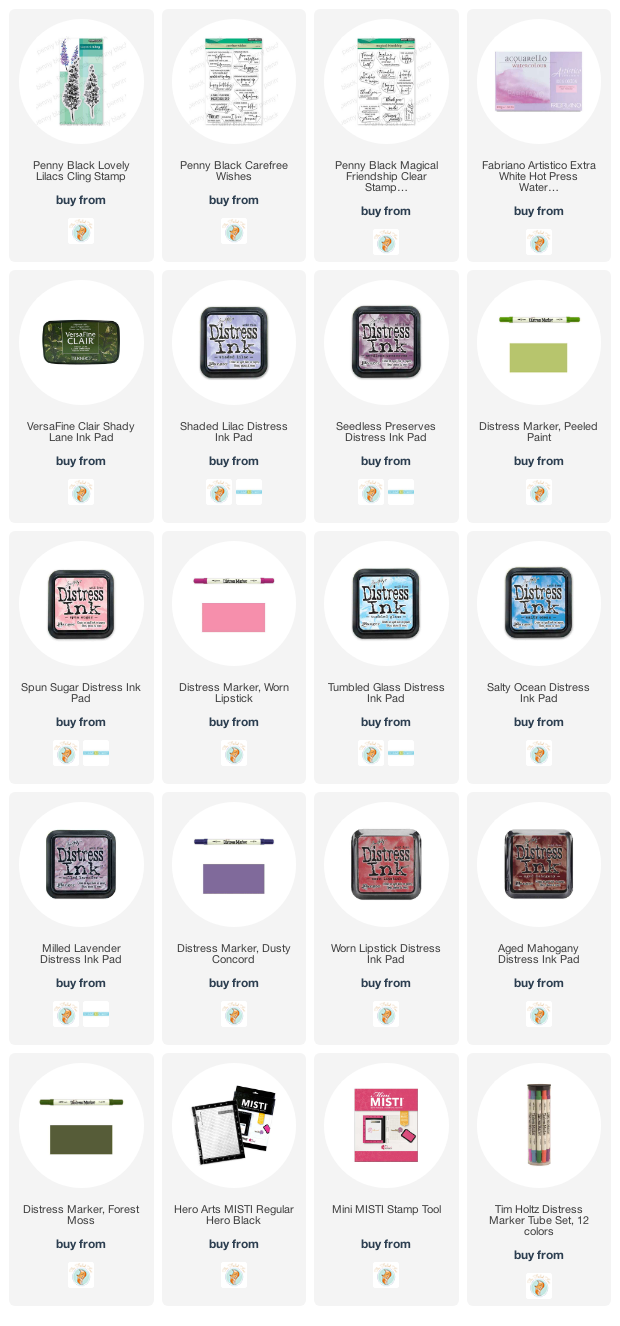
Autumn Bliss
Posted: September 30, 2019 Filed under: autumn bliss, calligraphy, Hand lettered, Penny Black, Watercolour | Tags: calligraphy, Dr Ph Martin Hydrus watercolor paints, Finetec artist mica watercolour paint, Penny Black stamps, Pointed pen 5 CommentsThis card is one of those rare ones where the end result is very close to the dreamed up idea.
I started by masking a piece of hot pressed watercolour paper with tape. I taped it into the stamp positioner using the grid lines as guides to get it straight and, wonder of wonders, it actually ended up straight. I stamped the pumpkins from the PB ‘autumn bliss’ set in Gina K’s jet black amalgam ink. I bought the amalgam so I could compare it to my current fave black, versafine clair nocturne. The amalgam stamped well and dried quickly but I didn’t find it superior to the versafine clair.
I wanted bold bright colours and wondered which of my watercolour mediums would give me that result. I settled on my Dr Ph Martin’s Hydrus liquid watercolours. They are definitely bold and bright! Of course they can be diluted for a softer look but I was happy to make the most of their vibrancy. Even though I put barely a drop of each colour on my palette I still ended up with more than I needed. I tried to limit my colour scheme by mixing some of my own colours. I started with gamboge and brilliant cad red for the middle pumpkin and painted all but the flowers. I then mixed the gamboge with the brilliant cad red for the left hand pumpkin and again painted all but the leaves. It was very tricky avoiding the leaves especially before I realised that I had my reading glasses on instead of my stronger ‘art glasses’. Sadly my art glasses are becoming my reading glasses so in the new year I am hoping to get some new ‘art glasses’ to help me see and paint all the fiddly bits. The right hand pumpkin is brill cad red and Venetian brown.
With my art glasses on I painted all the leaves and stalks with a green made by mixing gamboge with ultramarine. The flowers on the middle pumpkin I painted in a diluted deep red rose/ultramarine mix. I added little dots of gold to the right hand pumpkin using finetec pearlescent ink then used a rosy colour from the same set to add shimmer to the flowers. If I did the pumpkins again I think I would paint them one solid colour first with a little shadow and shading then use the pearlescent inks over the top to add all the flowers and leaves. The pearlescent inks are opaque and would not have let the underneath colour show through.
After all the pumpkin decorating, I painted the background with ultramarine. If you have masked with tape before you will know how satisfying it can be to peel back the tape to reveal crisp straight edges and also how frustrating when some paint has seeped underneath. Well, again, wonder of wonders, no seepage! Now, the last wonder of wonders is really the biggest. I occasionally do my own calligraphy sentiments, more often than not it does not end up straight, neat or the right size so I end up cutting the painted panel off and attaching it to a whole new panel in order to get rid of the messed up sentiment. This time I ruled my pencil lines, practiced the sentiment on a scrap, wrote it in pencil on the panel and finally wrote it with pointed pen in a mix of ultramarine and pearlescent ink. The next step was key; I have messed it up in the past. I left the room and went and had my lunch, that way I was not tempted to erase the pencil before the writing was dry, dry dry! I used one of those nifty battery operated erasers to gently erase all the pencil and then did a happy dance!
I hope you don’t think I am overdoing it in my satisfaction with this card, I know it’s nothing out of the ordinary, it’s just that it could have gone wrong in quite a few places but happily it didn’t.
Supplies
Watercolour on coloured paper
Posted: May 10, 2019 Filed under: bunches for you, flower fantasy, peaceful time, Penny Black, Watercolour | Tags: canal paper, Penny Black stamps, sennelier watercolours 10 CommentsI came across some interesting paper at Art Noise when I was in Kingston on the weekend. It is called canal paper and is made by Paperterie St. Armand in Montreal. The pad of paper I bought has six different colours, all made from cotton rag; the fibres are left from clothing company offcuts. There is no bleaching or dyeing, the colour of the papers is from the colour of the cotton fabrics.
The paper is not the only new thing I tried out on these cards. I also have some delicious new Sennelier watercolours. I was interested to see how they looked on the coloured paper and also how the paper held up to a watercolour wash.
These cards are one layer making use of the natural deckled edge on one edge of the paper pad. I scored the paper then taped it to my glass mat, lining up the frog tape with the grid on my mat to create a masked panel in the centre of the card front. I used three colours of paint on each card and matching envelopes. I was impressed that no paint seeped under the edge of the tape so I had crisp edges to my watercolour panels.
I stamped the new line art stamps from Penny Black with Ranger archival inks and was very happy with the crisp prints on the paper, I thought there might be a bit of bleed as the paper has quite a soft surface but the stamping was crisp and there was no bleed through with the watercolour washes. For the two cards above I simply stamped the image over the watercoloured section. On the card below I did the same then added some extra painting to the flowers using the same paint colours. The colour of the paper makes the paint colours more muted than they would be on white or cream but I liked the more rustic simple style on these cards. You could definitely use this technique with the traditional white watercolour paper and achieve much brighter results.
My cards measure 5″x 4¼” so I decided to make custom envelopes from the same paper. I used the We R Memory Keepers 1-2-3 punch board to make an envelope to fit and before I taped it together I masked a section of the front so I could watercolour in the same colours used for the cards.
Supplies
Watercolour pencil cacti
Posted: August 30, 2018 Filed under: Happy together, Watercolour | Tags: Faber-Castell Albrecht Durer Watercolour pencils, Penny Black stamps, Ranger Distress inks 12 CommentsI’ve worked with this stamp before, last time with bister powder to colour it. It took longer with watercolour pencils but the process was quite relaxing. I used my tried and true Albrecht Dürer watercolour pencils from Faber Castell and limited my choices to light green, dark green, light blue, purple and brown.
I stamped the image from the PB ‘happy together’ set in crushed olive distress ink then used a paint brush with my watercolour pencils to add colour. I painted shadows in a mix of brown and purple then matted with some purple cardstock.
Now, help me out here, what is the right occasion for sending a cacti card??
Supplies
Stamps: happy together

Paper: hot pressed watercolour, neenah natural white, purple


Inks: crushed olive distress ink
,
Also: Albrecht Dürer watercolour pencils
Winter Solace
Posted: August 22, 2018 Filed under: Stamped Landscapes, Watercolour, winter solace | Tags: Penny Black stamps, Ranger Distress inks 4 CommentsMy vintage snowy scenes continue with this new Penny Black stamp ‘winter solace’. I kept it simple once again with vintage photo ink plus some black for shadows and some blue for the sky. The technique is similar to the one I shared in my recent video but because this is a more solid stamp it is necessary to blend the ink more carefully so as not to obscure the details in the stamp. I stamped in vintage photo distress ink on cold pressed watercolour paper.
Rather than use watercolour pencils to add extra colour, I pressed black soot, vintage photo and broken china onto my glass mat to use as needed.
When blending the vintage photo ink I dabbed with a damp paintbrush instead of blending. I didn’t want the ink to cover the walls of the church uniformly, instead I left areas white and added black for shadows wherever I thought there would be some.
I added black under the eaves, under the windows and on the corners.
I used a pencil to lightly draw a roof line to give me a guide for painting blue sky. I painted right up to the pencil line and edges of building with water then added broken china ink to fill sky. I dabbed the blue ink around the edges of the trees with the point of the brush.
I blended water over the stamped sections of trees taking care to leave the white areas to look like snow.
To add some snowbanks to the foreground I painted a few lines of vintage photo ink with a fine tip brush then blended them with water.
To complete the card I added a sentiment from the new ‘Christmas sentiments’ set.
I’m looking forward to trying some other looks and colour schemes with this stamp.
Supplies
Stamps: winter solace, Christmas sentiments


Inks: vintage photo, black soot, broken china distress ink



Paper: cold pressed watercolour paper

Also: cutterpillar glass mat

Tranquil Hamlet Video
Posted: August 20, 2018 Filed under: Stamped Landscapes, tranquil hamlet, Watercolour | Tags: Faber-Castell Albrecht Durer Watercolour pencils, Penny Black stamps, Ranger Distress inks 7 CommentsYou’ve probably heard by now there is a new Penny Black release in town! Two actually, a big beautiful Christmas release and a fun fall release. The catalogues can be viewed here. I’ll be featuring vintage style snowy scenes all week here on the blog even though the sun is shining and the grass is green outside!
This lovely stamp called ‘Tranquil Hamlet’ is stamped in vintage photo ink and coloured with Faber Castell Albrecht Dürer watercolour pencils on hot pressed watercolour paper. Watch the video to see how

Thanks for dropping by; I’ll be back tomorrow with another snowy scene.
Supplies
Stamps: Tranquil Hamlet

Ink: vintage photo distress ink

Paper: hot pressed watercolour paper

Pencils: Faber Castell Albrecht Dürer Watercolour pencils (199, 159, 154, 151, 126)
Tools: stamping platform
.





